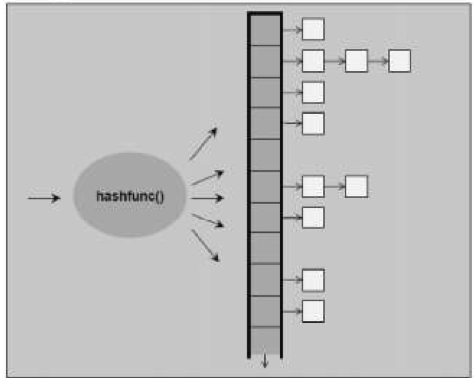STL标准库-容器-unordered_set
2024-09-30 00:59:20
技术在于交流、沟通,本文为博主原创文章转载请注明出处并保持作品的完整性
unordered_set与与unordered_map相似,这次主要介绍unordered_set
unordered_set它的实现基于hashtable,它的结构图仍然可以用下图表示,这时的空白格不在是单个value,而是set中的key与value的数据包
有unordered_set就一定有unordered_multiset.跟set和multiset一样,一个key可以重复一个不可以

unordered_set是一种无序集合,既然跟底层实现基于hashtable那么它一定拥有快速的查找和删除,添加的优点.基于hashtable当然就失去了基于rb_tree的自动排序功能
unordered_set无序,所以在迭代器的使用上,set的效率会高于unordered_set
template<class _Value,
class _Hash = hash<_Value>,
class _Pred = std::equal_to<_Value>,
class _Alloc = std::allocator<_Value> >
class unordered_set
: public __unordered_set<_Value, _Hash, _Pred, _Alloc>
{
typedef __unordered_set<_Value, _Hash, _Pred, _Alloc> _Base; ... }
参数1 _Value key和value的数据包
参数2 _Hash hashfunc获取hashcode的函数
参数3 _Pred 判断key是否相等
参数4 分配器
下面介绍一下unordered_set的基本使用,最后我会分享一下我的测试代码
一 定义
//定义
unordered_set<int> c1; //operator=
unordered_set<int> c2;
c2 = c1;
二 容量操作
//判断是否为空
c1.empty(); //获取元素个数 size()
c1.size(); //获取最大存储量 max_size()
c1.max_size();
三 迭代器操作
//返回头迭代器 begin()
unordered_set<int>::iterator ite_begin = c1.begin(); //返回尾迭代器 end()
unordered_set<int>::iterator ite_end = c1.end(); //返回const头迭代器 cbegin()
unordered_set<int>::const_iterator const_ite_begin = c1.cbegin(); //返回const尾迭代器 cend()
unordered_set<int>::const_iterator const_ite_end = c1.cend(); //槽迭代器
unordered_set<int>::local_iterator local_iter_begin = c1.begin();
unordered_set<int>::local_iterator local_iter_end = c1.end();
四 基本操作
//查找函数 find() 通过给定主键查找元素
unordered_set<int>::iterator find_iter = c1.find(); //value出现的次数 count() 返回匹配给定主键的元素的个数
c1.count(); //返回元素在哪个区域equal_range() 返回值匹配给定搜索值的元素组成的范围
pair<unordered_set<int>::iterator, unordered_set<int>::iterator> pair_equal_range = c1.equal_range(); //插入函数 emplace()
c1.emplace(); //插入函数 emplace_hint() 使用迭代器
c1.emplace_hint(ite_begin, ); //插入函数 insert()
c1.insert(); //删除 erase()
c1.erase();//1.迭代器 value 区域 //清空 clear()
c1.clear(); //交换 swap()
c1.swap(c2);
五 篮子操作
//篮子操作 篮子个数 bucket_count() 返回槽(Bucket)数
c1.bucket_count(); //篮子最大数量 max_bucket_count() 返回最大槽数
c1.max_bucket_count(); //篮子个数 bucket_size() 返回槽大小
c1.bucket_size(); //返回篮子 bucket() 返回元素所在槽的序号
c1.bucket(); // load_factor 返回载入因子,即一个元素槽(Bucket)的最大元素数
c1.load_factor(); // max_load_factor 返回或设置最大载入因子
c1.max_load_factor();
六 内存操作
// rehash 设置槽数
c1.rehash(); // reserve 请求改变容器容量
c1.reserve();
七 hash func
//hash_function() 返回与hash_func相同功能的函数指针
auto hash_func_test = c1.hash_function(); //key_eq() 返回比较key值得函数指针
auto key_eq_test = c1.key_eq();
八 测试代码
#include <iostream>
#include <unordered_set>
using namespace std; namespace wzj001{
void coutUnorderedSet(std::unordered_set<int>& m, string funcName) {
std::unordered_set<int>::iterator it;
std::cout << funcName << ": ";
for ( it = m.begin(); it != m.end(); it++ )
std::cout << *it << " ";
std::cout << std::endl;
} void initUnorderSet(unordered_set<int>& tmp)
{
for(int i = ; i < ; i++)
tmp.insert(i);
} string turnBoolToString(bool tmp)
{
return tmp ? "true" : "false";
} void basicOperationUnorderedSet()
{
//定义
std::unordered_set<int> c;
// 普通插入,返回pair<迭代器,插入是否成功>
pair<unordered_set<int>::iterator, bool> c_insert = c.insert();
cout << "指向key的迭代器: " << *c_insert.first << " 插入是否成功 "<< turnBoolToString(c_insert.second)<<endl;
pair<unordered_set<int>::iterator, bool> c_insert2 = c.insert();
cout << "指向key的迭代器: " << *c_insert2.first << " 插入是否成功 "<< turnBoolToString(c_insert2.second)<<endl;
pair<unordered_set<int>::iterator, bool> c_insert3 = c.insert();
cout << "指向key的迭代器: " << *c_insert3.first << " 插入是否成功 "<< turnBoolToString(c_insert3.second)<<endl; //按指定区域插入
std::unordered_set<int> c_insert_region;
c_insert_region.insert(c.begin(), c.end());
coutUnorderedSet(c_insert_region, "按指定区域插入"); //构造插入
std::unordered_set<int> c_emplace;
c_emplace.emplace();
c_emplace.emplace();
c_emplace.emplace();
coutUnorderedSet(c_emplace, "构造插入"); //迭代器插入
std::unordered_set<int> c_emplace_hint;
c_emplace_hint.emplace_hint(c_emplace_hint.begin(), );
c_emplace_hint.emplace_hint(c_emplace_hint.begin(), );
c_emplace_hint.emplace_hint(c_emplace_hint.begin(), );
coutUnorderedSet(c_emplace_hint, "迭代器插入"); //删除
std::unordered_set<int> c_erase;
initUnorderSet(c_erase);
coutUnorderedSet(c_erase, "初始化c_erase");
//指定位置删除
c_erase.erase(c_erase.begin());
coutUnorderedSet(c_erase, "指定位置删除"); //指定key删除
c_erase.erase();
coutUnorderedSet(c_erase, "指定key删除"); //指定区域删除
c_erase.erase(c_erase.begin(), c_erase.end());
coutUnorderedSet(c_erase, "指定区域删除"); //交换
c.swap(c_emplace);
coutUnorderedSet(c, "交换"); } void unorderSetElementLookup()
{
//查找
std::unordered_set<int> c_find;
initUnorderSet(c_find);
std::unordered_set<int>::iterator find_iter = c_find.find();
if(find_iter != c_find.end())
{
cout<< "找到元素 : "<< *find_iter << endl;
}
else
cout<< "没找到 !"<< endl; cout << "value出现次数 :" <<c_find.count()<< endl; //set key不可重复 pair<std::unordered_set<int>::iterator, std::unordered_set<int>::iterator> tmp = c_find.equal_range(); if(tmp.first != c_find.end()&& tmp.second != c_find.end())
{
cout << "该值所在区间为[" << *tmp.first << "," << *tmp.second << "]" << endl;
}
} void unorderSetBuckets()
{
//篮子操作
std::unordered_set<int> c_buckets;
initUnorderSet(c_buckets);
cout << "篮子个数: " << c_buckets.bucket_count()<< endl;
cout << "篮子大小: " << c_buckets.bucket_size() << endl;
cout << "最大篮子个数: " << c_buckets.max_bucket_count() << endl;
cout << "该值所在篮子序号: " << c_buckets.bucket() << endl;
} void unorderSetHashPolicy()
{
std::unordered_set<int> c_;
cout << "负载: "<< c_.load_factor()<< endl;
initUnorderSet(c_);
cout << "负载: "<< c_.load_factor()<< endl;//使用的篮子数/篮子总数 默认的篮子数为11
cout << "最大负载: "<< c_.max_load_factor() << endl;
c_.reserve();//预设篮子数 ,但是还没有设定
c_.rehash();//设定篮子数
} void unorderSetObservers()
{
std::unordered_set<int> c_;
initUnorderSet(c_);
std::unordered_set<int>::hasher xxx = c_.hash_function();
std::unordered_set<int>::key_equal zzz = c_.key_eq();
cout << "hash_func: " << xxx() << endl;
cout << "key_eq: " << turnBoolToString(zzz(,)) << endl;
}
} int main()
{
wzj001::basicOperationUnorderedSet();
wzj001::unorderSetElementLookup();
wzj001::unorderSetBuckets();
wzj001::unorderSetHashPolicy();
wzj001::unorderSetObservers();
}
最新文章
- 五个典型的 JavaScript 面试题
- IOS开发 应用程序图标数字角标
- 开放产品开发(OPD):OPD框架
- Java基础(57):Eclipse中环境配置(视图字体颜色行号调试快捷键等等)
- 使用SCP在命令行传输文件
- 比较满意设计的一次作业 JDBC宠物管理
- DJANGO模板的BLOCK自定义技巧
- 未在本地计算机上注册“Microsoft.Jet.OLEDB.4.0”提供程序。
- Datables wrning(table id='example'):Cannot reinitialise DataTable.
- 2. Singleton模式
- POJ 1094 Sorting It All Out (拓扑排序) - from lanshui_Yang
- 使用apache daemon让java程序在unix系统上以服务方式运行
- File的getParentFile()和getParent()
- Ruby学习之动态调用
- mysql 性能优化思路 - mysqldumpslow /tmp/mysql-slow.log 字符集 utf-8 create database
- 如何在sublime编辑器中,执行命令行脚本
- POJ2421 Constructing Roads【最小生成树】
- dd 命令的使用
- 小程序登录、微信网页授权(Java版)
- ACdream原创群赛__15